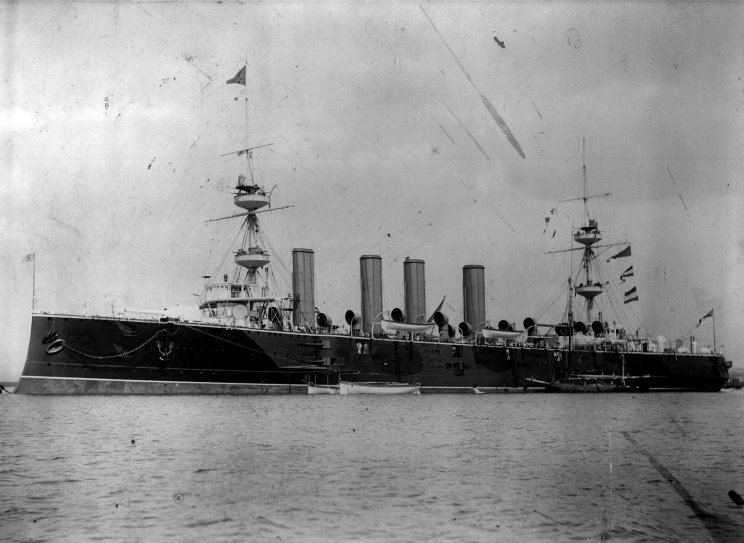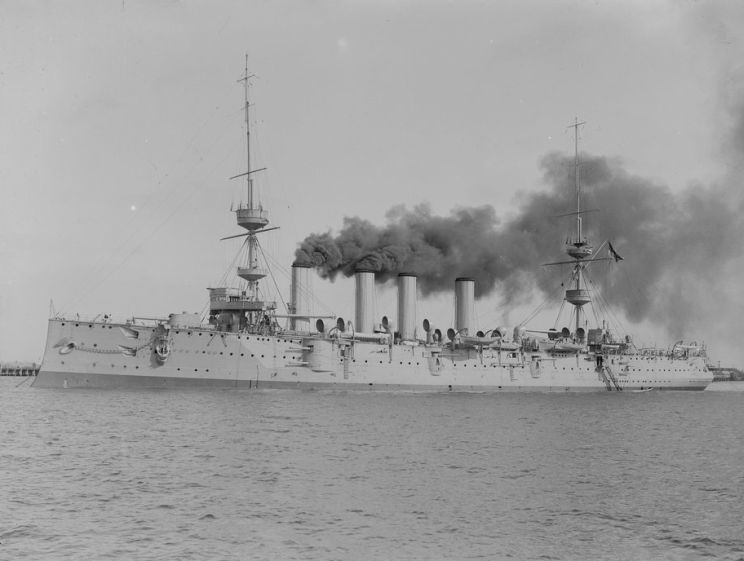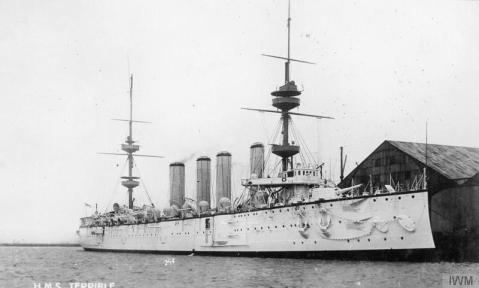Name HMS Powerful Fate Sold 31 August 1929 Construction started 1894 Length 152 m Draft 8.2 m | Laid down 1894 Launched 24 July 1895 Displacement 12.88 million kg | |
 | ||
Renamed Impregnable, November 1919 Reclassified Training School, November 1919 Builders Vickers Limited, Barrow-in-Furness | ||
HMS Powerful was a ship of the Powerful class of protected cruisers in the Royal Navy. She served with her sister ship, Terrible, on the China Station and provided landing parties which fought in the relief of the Siege of Ladysmith in the Second Boer War. Crews from the two ships also took part in suppressing the Boxer Rebellion in China. After 1904 they were laid up as an economy measure.

Career
Powerful was built by Vickers Limited, Barrow-in-Furness and launched on 24 July 1895 by the Duchess of Devonshire.

In 1897 Captain Hedworth Lambton commanded Powerful, which was one of the largest warships of the time, on a posting to China. On the return voyage in 1899 he was ordered to Durban, South Africa at an important point in the Second Boer War. He stopped at Mauritius, and on his own initiative picked up a battalion of soldiers stationed there. Knowing that the British forces at Ladysmith urgently needed more powerful guns, Captain Percy Scott from Powerful's sister ship, Terrible, devised carriages to transport naval cannon, and Lambton then led a Naval Brigade from Powerful to the rescue with four 12-pounders and two other guns.

The journey to Ladysmith from Durban was 189 miles (304 km). They began by special train then with oxen pulling the guns but when the oxen died the sailors took over pulling the guns themselves. In this endeavour they manhandled the guns "through the wild and broken country" of the South African veldt and "arrived in the nick of time" to play "a most important role in the defence of the town". Although the Boer attackers were kept at bay unfortunately the Naval brigade became besieged themselves. A second Naval brigade from Terrible left Durban for Ladysmith and joined with the relief column led by General Buller and assisted in the lifting of the siege.
The field gun competition commemorates the participation of Terrible and Powerful in the relief of Ladysmith.

On 30 October 1899 the Naval Brigade of Powerful attacked Boer positions at Lombards Kop, Ladysmith. On 25 November 1899 the Naval Brigade from Powerful fought in the Battle of Graspan against the Boers in South Africa. On 6 January 1900 the Naval Brigade from Powerful repulsed a strong Boer attack at Ladysmith.

The enthusiastic response in Britain to the "heroes of Ladysmith" was enormous and made Captain Hedworth Lambton a well-known public figure. Queen Victoria sent a telegram saying, "Pray express to the Naval Brigade my deep appreciation of the valuable services they have rendered with their guns." while a reception and celebratory march through London were among the first events ever recorded on film.
A newspaper described the Powerful's return home:
Lambton was awarded the CB, and it was in this year that his caricature was published in Vanity Fair. In 1921 a new Primary School in Ladysmith was named after Lt Frederick Greville Egerton, a gunnery officer from the Powerful who lost his life during the action at Ladysmith.
Powerful returned to the United Kingdom, and in 1901-1902 had a refit at Portsmouth Dockyard.
In August 1905 Captain Lionel Halsey took command of Powerful, as flag captain to Sir Wilmot Fawkes as Commander-in-Chief Australia Station. At the time Powerful was commissioning as Flagship on the Australia Station. Halsey remained in that post until 1908.
At the beginning of December 1905, Powerful was at Fremantle in Western Australia.
On 3 February 1908 the first trans-Tasman radio transmission was made via Powerful which was in the Tasman Sea.
A Sydney Morning Herald journalist, Charles Bean joined the ship in August 1908 as special correspondent to report the visit of sixteen American warships — the Great White Fleet. At the time Powerful was flagship of the Royal Navy squadron on the Australian Station. Bean wrote a book, With the Flagship in the South (London, 1909), based on his reports, with photographs, drawings and a water-colour frontispiece by the author, and had it published at his own expense.
In 1911 Powerful visited Auckland, New Zealand to inspect the facilities and recommended the setting up of a Naval Store Organisation.
During the First World War, Powerful and Terrible had most of their armament removed and served as troop transports and later accommodation ships.
After the end of the war, Powerful was renamed Impregnable in November 1919 and converted to a training ship. After ten years of this, she was sold on 31 August 1929 for breaking up.
